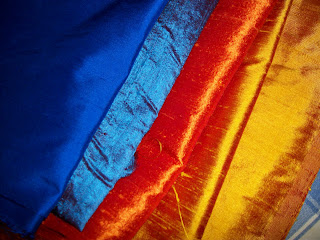Sometimes working on a tallit feels less like sewing and more like construction work. The "Not Mets" orange and blue tallit is no exception. I have been working on constructing the stripe which are being made out of four different colors of silk shantung. The four colors are also four entirely different qualities and weights of fabric.
If you were someone taught to sew by a home-ec teacher, you would know that this is not a good thing to do. You are supposed to sew fabrics of similar weights one to another. I am self taught, so I am going to pretend that I don't know this piece of sewing wisdom.
One of the major reasons for this feigned ignorance is the fact that it is impossible to find four colors of shantung in the same weight. While the Shantungs that I purchased, are probably not hand woven, the tangerine colored silk feels like it was made on not quite mechanized looms made with silk threads that were not particularly closely inspected for uniformity. It looks a whole lot like the scarves being sold as Thai silk. In short, it has the feel and look of hand woven work. The dark blue silk is made with fine threads evenly woven. The two other silks fall between the two extremes.
So why did I buy four silks that vary so widely? Because for this tallit, I was selecting fabrics for their color. I went to several stores to find the right silks. Orange must be out of favor at the moment because most stores didn't have any orange shantung at all. None, not one bolt.So, I had to choose from what was out there.
Shantung was the first silk that I ever sewed with. Shantung has many lovely qualities. Unlike chiffon, it stays put when you cut it. Unlike a satin, it's easy to sew and the layers of silk don't decide to go visiting relatives on opposite sides of the globe as you stitch it. Shantung does have one unpleasant quality. It shreds like crazy. When I work with it long threads of silk migrate away from the strips of fabric and end up wrapping themselves around my feet. Before I leave the house I have to make sure that my legs are not covered with long silk threads. The colors are pretty, but not what wants to wear walking down Broadway.
Ethan, my client for this piece wanted a tallit that was blue and orange but didn't feel like a "Mets" themed tallit. We decided that I would do a variant on Seminole piece work. For those of you not familiar with the term, the Seminole Indians in Florida, developed a technique of slicing and dicing fabrics that creates complex patterns. When I started sewing in the early 1990's I began by making quilts. Seminole piece work was experiencing a revival.
When I began sewing, I was a religious reader of Threads Magazine, which in those days was a hand work magazine of wide range. Issue after issue I would be introduced to mind-blowing techniques that I just had to try, as son as I had finished reading the article introducing the technique. For me, it was heady reading. These days Threads has a much more narrow focus of garment making, which is nice, but not nearly as much fun as learning how to make a rug loom out of discarded crutches. No, I didn't make the loom, but it's just nice to know that one can.
The stripes on this tallit are being made in a wild interpretation of Seminole piece work. The tallit should look fun from both far away and close up. You can see a chunk of the pieced stripe. Don't let the messiness throw you. It will look all tidy when all the raw ends are enclosed.


This is going to be a real visual treat. I love Seminole piece work. When I lived in South Florida I would sometimes see the Seminole women in their traditional dresses. Tiny, tiny little piece work strips would embellish their skirts. I had to try so hard not to stare.
ReplyDeleteFor some strange reason I just started thinking about fry bread. The kids are home on a snow day. Bwaaaa.....in Florida. They might enjoy that for a snack.